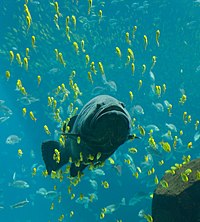
Photo from wikipedia
During the process of wave slamming on a structure with sharp corners, the wave receding after wave impingement can induce strong negative pressure (relative to the atmospheric pressure) at the… Click to show full abstract
During the process of wave slamming on a structure with sharp corners, the wave receding after wave impingement can induce strong negative pressure (relative to the atmospheric pressure) at the bottom of the structure, which is called the suction effect. From the practical point of view, the suction force induced by the negative pressure, coinciding with the gravity force, pulls the structure down and hence increases the risk of structural damage. In this work, the smoothed particle hydrodynamics (SPH) method, more specifically the δ+SPH model, is adopted to simulate the freak wave slamming on a fixed platform with the consideration of the suction effect, i.e., negative pressure, which is a challenging issue because it can cause the so-called tensile instability in SPH simulations. The key to overcome the numerical issue is to use a numerical technique named tensile instability control (TIC). Comparative studies using SPH models with and without TIC will show the importance of this technique in capturing the negative pressure. It is also found that using a two-phase simulation that takes the air phase into account is essential for an SPH model to accurately predict the impact pressure during the initial slamming stage. The freak wave impacts with different water depths are studied. All the multiphase SPH results are validated by our experimental data. The wave kinematics/dynamics and wave impact features in the wave-structure interacting process are discussed, and the mechanism of the suction effect characterized by the negative pressure is carefully analyzed.During the process of wave slamming on a structure with sharp corners, the wave receding after wave impingement can induce strong negative pressure (relative to the atmospheric pressure) at the bottom of the structure, which is called the suction effect. From the practical point of view, the suction force induced by the negative pressure, coinciding with the gravity force, pulls the structure down and hence increases the risk of structural damage. In this work, the smoothed particle hydrodynamics (SPH) method, more specifically the δ+SPH model, is adopted to simulate the freak wave slamming on a fixed platform with the consideration of the suction effect, i.e., negative pressure, which is a challenging issue because it can cause the so-called tensile instability in SPH simulations. The key to overcome the numerical issue is to use a numerical technique named tensile instability control (TIC). Comparative studies using SPH models with and without TIC will show the importance of this technique in capturing ...
Journal Title: Physics of Fluids
Year Published: 2019
Link to full text (if available)
Share on Social Media: Sign Up to like & get
recommendations!